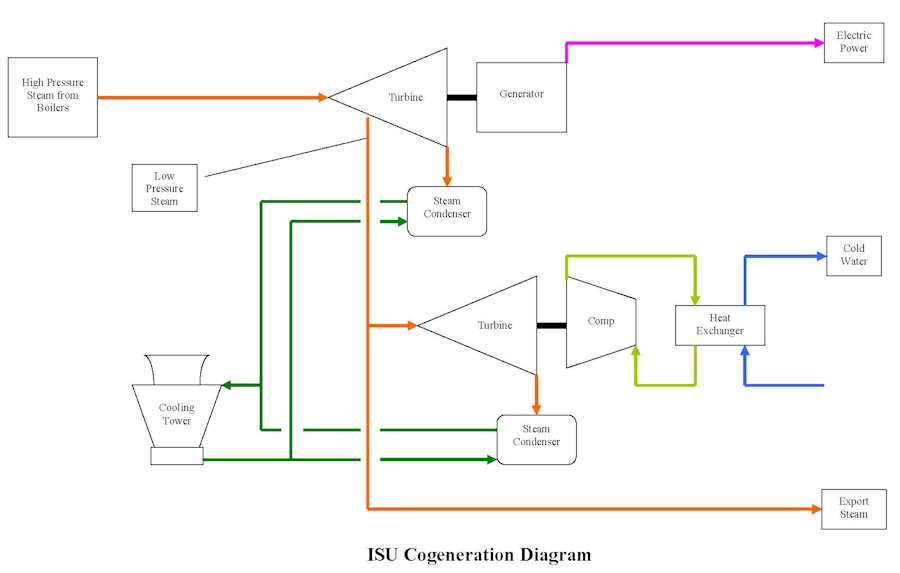Environmental Performance
Cogeneration: Combined Heat and Power
Most colleges and universities provide their own heating and cooling, but they usually purchase electric power produced by a conventional power plant. However, by combining these processes, a facility can achieve higher energy efficiency and significantly reduce energy costs. The term for this process is "Combined Heat and Power" or "Cogeneration". Iowa State University built its first power plant in 1891 and designed the plant to use the cogeneration process to provide heating and electricity to the campus. Today, Iowa State University supplies all the energy necessary for heating and cooling the campus while simultaneously generating electric power.
Conventional power generating plants discharge large quantities of low-grade thermal energy to the atmosphere from the generator’s steam turbine. This energy is not usable for additional power generation and is the largest energy loss in the process of producing electricity. Because of these losses, the thermal efficiency of a typical utility power plant is 33-35%.
The cogeneration process is able to utilize this low-grade heat for heating buildings and other processes, greatly increasing efficiency. The cogeneration process can achieve overall efficiencies of more than 70%. Iowa State's Power Plant typically operates at an overall thermal efficiency of approximately 60%.
Because of the higher efficiency, the university consumes less fuel to provide energy to campus, resulting in lower costs. Other campuses operate cogeneration plants, similar to Iowa State University. These include the University of Iowa, University of Illinois, University of Missouri, Purdue University, Michigan State University, and the University of North Carolina.

Energy Production: Reduce Emissions
Using cogeneration also has an environmental benefit. Burning of any fuel produces air emissions as a by-product. These emissions include sulfur dioxide, nitrogen oxides, particulate and carbon dioxide. These emissions have a negative effect on the environment. The increased efficiency resulting from the cogeneration process also reduces emissions, because the university burns less fuel.
Since 2010, the university has been on a journey to upgrade the power plant and become more sustainable. New environmental regulations, replacement of aging equipment and alternative energy sources have resulted in significant changes.
The university replaced older coal boilers with natural gas boilers. The natural gas boilers have more operating flexibility. As a result, utility staff have been able to operate the plant differently and increase efficiency. The university uses much less coal and is bringing renewable energy to campus. These changes reduced regulated emissions by over 80% and carbon dioxide emissions by approximately 25%.
Energy Demand Trends and Statistics
Energy Conservation
The power plant operating and maintenance staff strive to operate the plant as efficiently as possible and to keep the equipment in good operating condition. These efforts minimize energy costs for the campus. However, they can only do so much.
Since steam, electricity, and chilled water cannot be stored, the Power Plant must continuously produce the needed energy to meet university demands. Power plant staff have no control over the energy used by campus buildings, they just respond to the energy demand. If the university community can reduce its energy usage, there is an immediate reduction of fuel burned and air pollutants emitted into the environment.
Building occupants can easily control electricity usage. Customers can shut down computers, lights and research equipment that are not in use. By adjusting thermostat and gaining better control of space temperatures in buildings, steam and chilled water usage can be reduced. There are many opportunities in the buildings to reduce energy demand. Some of these require equipment replacement and other improvements, however much can be done by the building occupants themselves.
Energy Usage Trends and Statistics
Alternative Energy
Wind Energy Purchases
Iowa State University and the City of Ames are purchasing renewable wind energy from a large wind farm located in northeastern Story County. NextEra Energy Resources owns and operates the wind farm. High voltage transmission lines deliver the power from the wind farm to the City of Ames and ISU campus.
The amount of electricity received from the wind farm varies with wind and weather conditions. Wind energy production varies seasonally and tends to be highest in the winter and lowest in the summer. The wind farm typically provides about 10% of the university's electrical needs on an annual basis.
Photovoltaic Solar Panels
Two 10-kilowatt photovoltaic solar panels are located near the campus wind turbine, northeast of the ISU Power Plant. CB Solar, Inc. owns and operates the solar array and donates all the electricity to Iowa State. The solar array started operations in October of 2015. The electricity produced by the solar panels is delivered into the university’s electrical system.
Water Usage
Water resources are becoming an issue around the United States, especially in the western parts of the country. There is a limited amount of fresh water. As the population grows, resources are becoming limited. Water resources in Ames are not as scarce, but are a concern. Despite the recent flood events, Ames also has had a history of severe droughts. We all need to be aware of our water demands and do what we can to conserve this precious resource. Iowa State University is working to minimize water usage as it builds or remodels buildings. Use of low flow faucets, toilets are now the standard. Despite all our efforts Iowa State is a large water consumer. On average, the university uses about one million gallons per day of water.